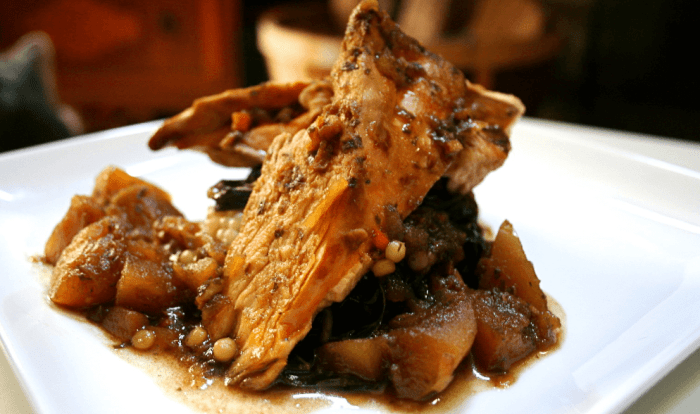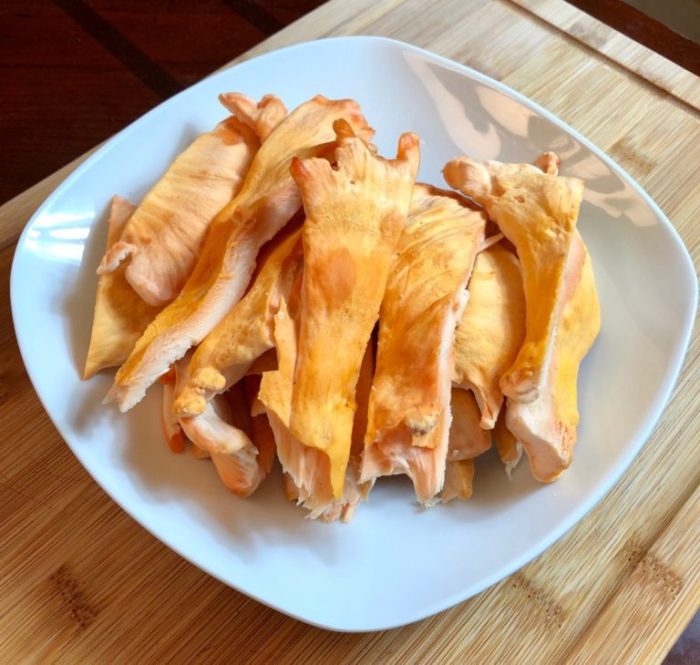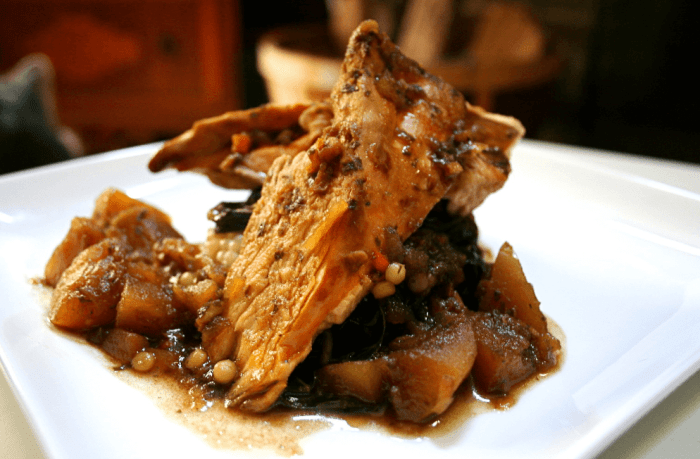
Embark on a culinary adventure with the chicken of the woods recipe, a delectable dish that celebrates the unique flavors of the wild. Discover the versatility of this edible mushroom as we explore its nutritional value, cooking methods, and creative culinary adaptations.
From sautéing to grilling and roasting, we’ll guide you through the art of preparing chicken of the woods, ensuring you create a dish that tantalizes your taste buds. Whether you’re a seasoned forager or a curious home cook, this recipe will inspire you to embrace the culinary wonders of the forest.
Overview of Chicken of the Woods: Chicken Of The Woods Recipe

Chicken of the Woods is a vibrant and distinctive mushroom found in forests worldwide. Its appearance is characterized by bright orange to yellow coloration, with a ruffled, chicken-like texture that resembles a coral reef. The mushroom typically grows on the base of hardwood trees, especially oaks, and can be found in clusters or individually.
Chicken of the Woods is highly prized for its culinary value and is considered edible in all stages of its growth. Its meaty texture and mild flavor make it a versatile ingredient that can be used in various dishes. It is often cooked like chicken, roasted, sautéed, or grilled, and can be added to soups, stews, and salads.
Nutritional Value and Health Benefits
In addition to its culinary appeal, Chicken of the Woods also offers nutritional benefits. It is a good source of fiber, which is essential for maintaining a healthy digestive system. It also contains several vitamins and minerals, including vitamin C, potassium, and niacin.
Some studies have suggested that consuming Chicken of the Woods may have potential health benefits, such as reducing inflammation and supporting the immune system. However, more research is needed to fully understand its health effects.
Recipe Development
Chicken of the Woods is a versatile mushroom that can be prepared in various ways. Here’s a step-by-step guide to prepare it for cooking:
Selecting the Best Ingredients
When selecting Chicken of the Woods, choose young, tender mushrooms with firm, meaty flesh. Avoid mushrooms that are slimy, bruised, or have dark spots.
To clean the mushrooms, gently brush off any dirt or debris with a soft brush or damp cloth. Do not wash them with water, as this can make them soggy.
Cooking Methods
Chicken of the Woods can be cooked using various methods, including sautéing, grilling, or roasting.
Sautéing
Sautéing is a quick and easy way to cook Chicken of the Woods. Heat a pan over medium heat and add some oil or butter. Add the mushrooms and cook until they are browned and tender.
Grilling
Grilling imparts a smoky flavor to Chicken of the Woods. Preheat your grill to medium heat and brush the mushrooms with oil. Grill for 5-7 minutes per side, or until cooked through.
Roasting
Roasting is a great way to caramelize the mushrooms and bring out their natural sweetness. Preheat your oven to 400°F (200°C). Toss the mushrooms with oil, salt, and pepper and roast for 15-20 minutes, or until tender and browned.
Flavor Enhancements
To enhance the flavor of Chicken of the Woods, try adding herbs and spices such as thyme, rosemary, garlic, or chili powder. You can also add a splash of white wine or lemon juice for extra acidity.
Variations and Adaptations

The versatility of Chicken of the Woods allows for endless culinary possibilities. It can be incorporated into various dishes, from soups and stews to salads and pizzas, offering unique flavors and textures.
Incorporating Chicken of the Woods into Soups and Stews
Chicken of the Woods adds a hearty and flavorful touch to soups and stews. Its meaty texture complements the richness of broths and sauces, making it an ideal ingredient for comfort food dishes. Consider adding it to creamy mushroom soups, hearty vegetable stews, or classic chicken noodle soups for a twist on traditional recipes.
If you’re craving a taste of the wild, consider trying a chicken of the woods recipe . This edible mushroom has a meaty texture and a slightly nutty flavor that makes it a great substitute for chicken in many dishes.
Whether you’re a seasoned forager or just starting out, there are plenty of resources available online to help you identify and prepare this delicious fungus.
Adding Chicken of the Woods to Salads
The crispy, golden-brown texture of Chicken of the Woods makes it an excellent addition to salads. It adds a crunchy contrast to fresh greens, grilled vegetables, and tangy dressings. Try incorporating it into a simple arugula salad with goat cheese and balsamic vinaigrette, or create a more elaborate salad with roasted root vegetables, quinoa, and a creamy tahini dressing.
Chicken of the Woods on Pizzas
Chicken of the Woods is a unique and flavorful topping for pizzas. Its meaty texture and earthy flavor pair well with a variety of cheeses and sauces. Experiment with different combinations, such as a classic Margherita pizza with fresh mozzarella and basil, or a more adventurous pizza with smoked Gouda, caramelized onions, and a creamy mushroom sauce.
For a more in-depth look at preparing chicken of the woods , check out this comprehensive guide. It covers everything from harvesting to cleaning to cooking, so you can be sure your meal turns out perfectly. Whether you’re sautéing it with vegetables or grilling it over an open flame, this versatile mushroom is sure to impress your taste buds.
Exploring Different Cuisines Featuring Chicken of the Woods, Chicken of the woods recipe
Chicken of the Woods is a popular ingredient in various cuisines worldwide. In North America, it is often used in soups, stews, and stir-fries. In Europe, it is commonly sautéed with butter and herbs or pickled in vinegar for preservation.
In Asia, it is often incorporated into noodle dishes, soups, and tempura preparations.
Troubleshooting and FAQs
Identifying, harvesting, and cooking Chicken of the Woods can present some common challenges. Understanding these issues and adopting proper techniques can help ensure a safe and enjoyable experience.
Identification
- Misidentification:Chicken of the Woods can resemble other mushrooms, such as the toxic Jack-o’-lantern mushroom. Always consult reliable field guides or consult with experienced foragers to ensure accurate identification.
- False Chanterelle:The False Chanterelle is a poisonous mushroom that shares similar characteristics with Chicken of the Woods. Be aware of key differences, such as the False Chanterelle’s darker orange color and forked gills.
Harvesting
- Ethical Harvesting:When foraging for wild mushrooms, practice ethical harvesting techniques. Only take what you need and leave plenty for others to enjoy.
- Contamination:Avoid harvesting mushrooms from areas near roads, industrial sites, or other sources of pollution.
- Spoilage:Chicken of the Woods can spoil quickly. Harvest only fresh, firm mushrooms and store them properly to prevent spoilage.
Cooking
- Toxicity:Raw Chicken of the Woods can cause gastrointestinal upset. Always cook mushrooms thoroughly before consumption.
- Rubberiness:If overcooked, Chicken of the Woods can become tough and rubbery. Cook for an appropriate amount of time to achieve the desired texture.
- Flavor:The flavor of Chicken of the Woods can vary depending on the growing conditions. Some mushrooms may have a stronger flavor than others.
Presentation and Plating
The presentation of your Chicken of the Woods dish can elevate the dining experience and make it visually appealing. Consider the following ideas to create a stunning plate:
Garnishes:Fresh herbs like thyme, rosemary, or parsley add a pop of color and freshness. Sautéed mushrooms or roasted vegetables provide additional texture and flavor.
Sauces:A simple butter sauce with lemon zest and garlic complements the earthy flavor of Chicken of the Woods. A creamy mushroom sauce or a tangy tomato sauce can also enhance the dish.
Accompaniments:Roasted potatoes, mashed cauliflower, or grilled polenta provide a hearty base for the Chicken of the Woods. A side salad with a light vinaigrette adds freshness and balance to the meal.
Importance of Presentation
Presentation is crucial as it influences the diner’s first impression and sets the tone for the dining experience. A well-plated dish stimulates the senses, enhances the flavors, and creates a memorable meal.
Final Wrap-Up

As you savor the earthy flavors of chicken of the woods, remember that this culinary journey is more than just a meal; it’s a connection to nature and a celebration of the wild’s bounty. Experiment with different variations, explore new cuisines, and share the joy of this unique mushroom with friends and family.
Bon appétit!
Common Queries
Can chicken of the woods be eaten raw?
No, chicken of the woods should not be consumed raw as it may contain harmful toxins. Cooking destroys these toxins and makes the mushroom safe to eat.
How do I identify chicken of the woods?
Chicken of the woods has a distinctive bright orange color and a velvety texture. It typically grows on dead or decaying oak trees and has a shelf-like appearance.
What are the health benefits of chicken of the woods?
Chicken of the woods is a good source of dietary fiber, protein, and antioxidants. It has been linked to potential health benefits such as boosting the immune system and reducing inflammation.